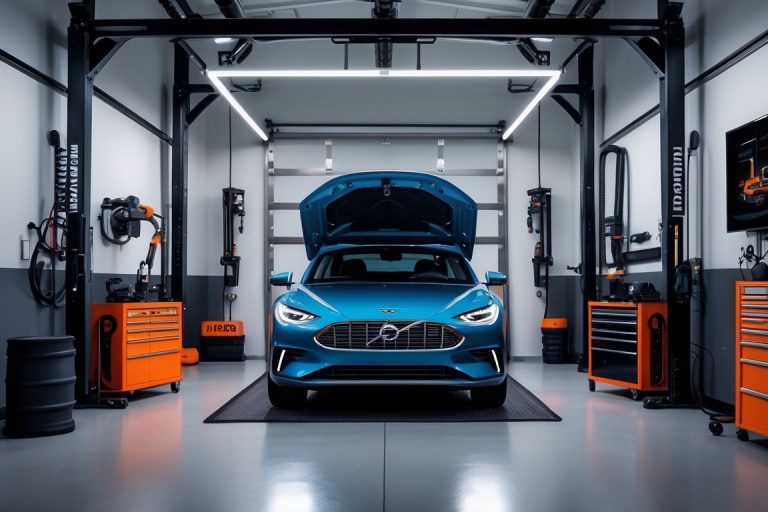Fast forward to 2030. You walk into your garage and instead of finding scattered tools, stained rags, and a dusty workbench, you’re greeted by a clean, organized, AI-powered workspace. Your car rolls in, syncs with your smart system, and begins diagnostics—without you lifting a finger.
This isn’t science fiction. It’s the next chapter of automotive innovation: the rise of the smart garage. As vehicles themselves become more connected and autonomous, the tools and spaces we use to maintain them are evolving in tandem. The garage of the future will empower car owners with technologies once reserved for pro shops—making DIY maintenance faster, smarter, and more precise than ever before.
Let’s dive into what your garage could look like by the end of the decade.
1. Smart Diagnostics: Your Garage Knows Your Car Better Than You Do
In 2030, your garage will likely be connected to your vehicle in real-time via Wi-Fi or cellular data. Smart diagnostic platforms will scan your car the moment it enters the garage—identifying issues ranging from low tire pressure to a failing alternator, all without plugging in a scanner.
Instead of deciphering vague dashboard alerts, your garage will display a detailed report on a wall-mounted screen or your smartphone, suggesting repairs and even walking you through the process step by step. Some systems may even be voice-activated—think of it as having a mechanic version of Alexa or Siri.
User Tip:
Start by integrating OBD-II Bluetooth scanners with mobile apps like FIXD or CarScanner. These are first steps toward building a more connected garage.
2. Robotic Assistance: Your New DIY Partner
Perhaps the most sci-fi leap comes from the growing field of automated repair robotics. Imagine a robotic arm in your garage that can rotate tires, change oil, or help lift engine components. These systems will use machine vision, haptic feedback, and AI-powered repair databases to assist or even perform tasks with minimal input.
Already, some advanced workshops and enthusiast garages are experimenting with programmable robotic tools. By 2030, expect consumer-grade versions that combine automation with intuitive UI—making them ideal for both seasoned mechanics and beginners.
User Tip:
Watch for startups offering modular robot assistants for home garages. Early adopters may get ahead with basic systems that can hold parts, pass tools, or assist with repetitive tasks.
3. Smart Lifts and Modular Workspaces
Goodbye to bulky jacks and rigid workbenches. The future garage will feature smart vehicle lifts—compact, foldable platforms that adjust height based on the task and recognize different vehicle models. Sensors will keep them safe, stable, and perfectly balanced.
Complementing this are modular tool walls and work surfaces with touch-sensitive panels, built-in lighting, and even AR-assisted displays that can overlay repair guides directly onto your workspace.
Imagine pointing your phone or smart glasses at your brake system, and seeing animated overlays guiding you through the repair in real time. This combination of augmented reality and modular tools will redefine DIY learning.
User Tip:
Upgrade your current setup with mobile lift systems and magnetic modular tool panels. These innovations are already on the market and will only improve with time.
4. AI Integration and Predictive Maintenance
Artificial intelligence won’t just assist with real-time diagnostics—it will also track your vehicle’s wear patterns, driving habits, and service history to predict issues before they arise. Your garage system might remind you to replace your brake pads in 800 miles, based on your braking behavior, not just a generic timeline.
Some systems will sync with your calendar and weather forecast to suggest the best time for maintenance—or even order parts for you automatically.
User Tip:
Pair your car’s app (Tesla, FordPass, MyBMW, etc.) with a digital calendar to start building this predictive habit. It’s the groundwork for future smart systems.
5. Sustainable and Space-Efficient Design
The garage of 2030 won’t just be smart—it’ll be sustainable. Expect solar integration, electric vehicle charging ports, energy-efficient lighting, and recycled materials. Garages may also double as home energy hubs, managing EV batteries and solar storage systems.
Modular storage and foldable tools will allow more functionality in less space—especially important as urban garages shrink in size.
User Tip:
Explore solar-powered garage kits and EV-ready electrical upgrades now. Early investment pays off as green tech becomes standard.
The Road Ahead
The garage is no longer just a place to park or tinker. It’s becoming a tech-savvy extension of your home—a space where artificial intelligence, robotics, and smart systems come together to make car care more accessible, accurate, and even enjoyable.
By 2030, you won’t need to be a master mechanic to handle complex repairs. With the right tools and tech, the garage of the future will empower everyone—from seasoned gearheads to curious beginners—to take control of their vehicle’s health like never before.
So, whether you’re prepping for a full garage upgrade or just curious about what’s coming next, one thing’s clear: the future of car maintenance is already pulling into the driveway.





